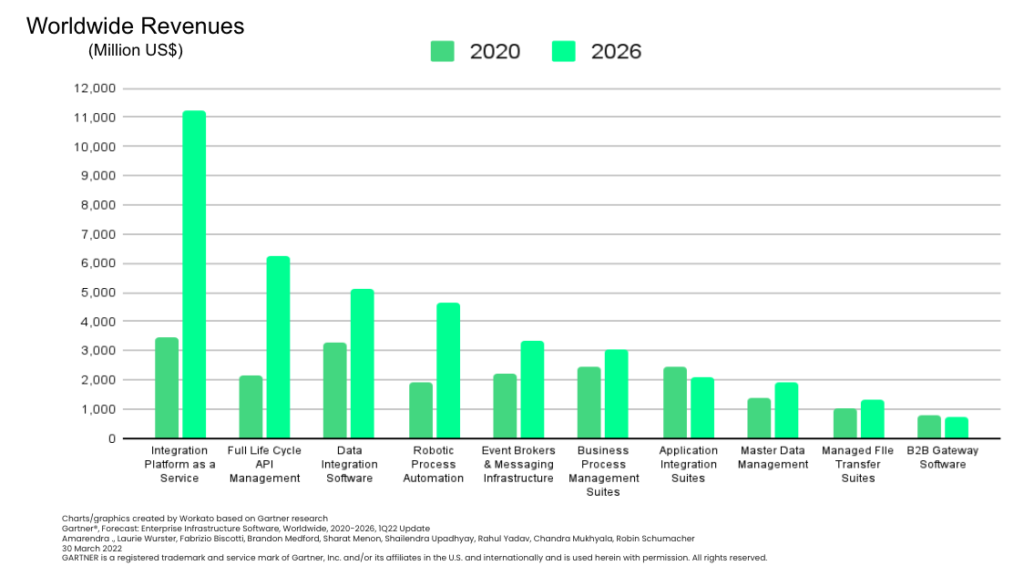Organizations can choose from a variety of tools when investing in digital transformation initiatives.
However, one tool in particular looks set to garner an overwhelming share of investment over the coming years—an integration platform as a service, or iPaaS.

Why are organizations looking to increase their spend on this platform? We’ll try to provide some clarity by breaking down the various benefits of using a traditional iPaaS. We’ll also address the platform’s inherent shortcomings and what you can do to solve for them.
To get us started, let’s align on what an iPaaS is.

Uplevel your approach to integration and automation with Workato
Workato, the leader in enterprise automation, offers a low-code/no-code UX that empowers your business teams to automate at scale—while working within well-defined governance policies.
What is an iPaaS?
It’s a cloud-based platform that lets you integrate your applications, data, and processes, regardless of whether they live in the cloud or on-premises. It also provides the foundation for a variety of use cases, including data synchronization, API-based composition, and automation.
Pros of using an iPaaS
Here are some of the many benefits of using an iPaaS:
1. Enables you to synchronize data across systems
Forcing employees to add or update information in their systems manually can lead to a variety of issues.
For one, human errors are bound to take place—leading to data inaccuracies that can influence poor decisions and breed misalignment across teams. Employees may also be slow to add information or forget to add it altogether, preventing it from being reviewed and acted upon appropriately. Finally, the process of inputting data can be grueling, tedious, and time-consuming, which translates to a poor use of time for your employees and experiences that’ll leave them dissatisfied.
Using an iPaaS, you can mitigate data entry by integrating your applications and implementing one-way or two-way data syncs. Moreover, the data can be synced in near real-time, ensuring that employees are able to access the data they need at the right time and in the right place.
2. Lets you avoid building integrations in-house
Building integrations in-house is almost always a challenge.
Each integration requires your developers to conduct processes around discovery, planning, and build to that API. And even once it’s built, they need to keep tabs on the API by following the company’s product release notes, where if any changes need to be addressed, they’ll need to respond quickly. This challenge becomes exponentially more challenging when you consider the dozens, if not hundreds, of integrations that your team needs to build and maintain.
Fortunately, an iPaaS can help by providing you with pre-built application connectors. These connectors can minimize the work your developers need to perform during both the implementation and maintenance phases, allowing your developers to focus instead on your core product.
Chris McClave, the CTO at Trakstar, a platform that offers a suite of HR products, explains the value of connectors in simple terms:
Related: A comparison between PaaS and iPaaS
3. Keeps your data and applications protected
The applications you’re integrating likely collect and store a variety of sensitive data, such as your employees’ or customers’ personal information.
Failing to provide adequate protection threatens to damage the trust you’ve established with critical stakeholders, both internally and externally, and it can lead you to become non-compliant with various data protection and privacy measures—forcing your organization to pay costly fines and deal with reputational damage.
An iPaaS can enable you to avoid the consequences highlighted above by providing robust data protection features, like role-based access control. Moreover, certain vendors are likely compliant with the laws and regulations that you and your stakeholders care about, including GDPR and HIPAA, and routinely perform comprehensive audits—such as SOC 2 Type-II.
4. Easy to review and manage integrations
When implemented in-house, your integrations can be hard to locate. Perhaps a few engineers know where an integration lives and how it runs, but it can be difficult to pinpoint which of your engineers have this information. Also, if they leave the company, the task of identifying and managing their integrations becomes nearly impossible.
Since an iPaaS provides a central location for viewing and managing your network of integrations, it allows you to be less reliant on specific engineers, and it better positions your team to troubleshoot and solve for any issues quickly.
5. Offers capabilities that extend beyond integration
As the iPaaS space matures, vendors are going on to embrace additional features and capabilities, including API management and event-brokering functionality. While this isn’t necessarily all that’s needed to engage in digital transformation (more on this later), it allows your team to move away from the applications that provide these point solutions, thus providing cost and time savings.
Related: SaaS vs iPaaS
Cons of using an iPaaS
An iPaaS isn’t without its shortcomings. Here are a few to be aware of:
1. Prevents the team at large from getting involved
Unfortunately, the majority of iPaaS vendors still require its users to have a certain degree of technical expertise. As a result, the majority of your employees can’t play a role in implementing or maintaining your integrations.
This can create several problems. For one, since IT and engineering are forced to handle the responsibility all by themselves, significant integration backlogs are likely to take shape, and delivery timelines are likely to get stretched. Also, since they might not be as familiar with the applications, data, and processes they’re integrating as those in business teams are, they’re less likely to ideate and execute integrations that deliver the highest return on investment.
Related: 3 challenges of iPaaS
2. Can’t automate workflows
While integrating applications and keeping their information in sync is clearly valuable, automating processes end-to-end is just as (if not more) impactful.
Using end-to-end automations, your team can reimagine how your processes work and unlock benefits that extend beyond time and cost savings. This includes enhanced business agility, engaged employees, satisfied clients, and more.
3. Fails to provide platform bots for your business communications platform
As you probably know already, employees spend a significant amount of time working from a business communications platform like Slack or Microsoft Teams. Slack, for example, reports that its users spend more than an hour per day, on average, working within the platform.
While an iPaaS can integrate business communications platforms with the rest of your tech stack, your employees need more functionality within the former to avoid context switching (i.e. moving back and forth between your business comms platform and other applications).
To truly make your business communications platform the hub your employees can work from, you’ll need customizable platform bots that allow an employee to access the data and actions from any application (that fall within their scope of permissions) within the business communications platform. In addition, the platform bots should be able to bring automations directly to your business comms platform—as shown below.

Related: The top benefits of workflow automation
Harness the benefits of a traditional iPaaS while addressing its shortcomings with Workato
Workato, the leader in enterprise automation, allows you to integrate your applications and automate your workflows. The platform also offers:
- A low-code/no-code UX, ensuring that both lines of business and IT can use the platform
- Workbot, a customizable platform bot that can work in Slack, Microsoft Teams, or Workplace from Meta
- Hundreds of thousands of automation templates and more than a thousand connectors to help your team ideate and implement integrations and automations faster and more easily
- Enterprise-grade governance and security features, including role-based access control, activity audit logs, etc.

